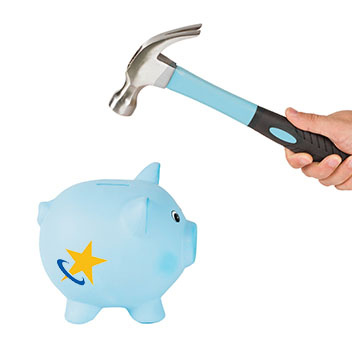The content and opinions provided on this site have not been provided or commissioned by any issuer of the financial products and/or services appearing on this site. The content and opinions have not been reviewed, approved or otherwise endorsed by an issuer. Offers may be subject to change without notice. For more information, please read our full disclaimer.
An emergency fund is your safety net for life’s unexpected moments. It’s a dedicated amount of money saved specifically for urgent expenses—not for buying new gadgets or treating yourself to shopping sprees. This fund is meant to handle true emergencies, giving you peace of mind and keeping you ready when life takes an unexpected turn.
- Unexpected car repairs
- Unexpected home repairs
- Job loss
- Personal injury
- Unanticipated medical care
- Sudden death of a loved one
In these situations, you may find yourself in dire need of a large amount of cash to quickly cover unexpected expenses. This is where your safety net comes in handy.
Since the unexpected can happen in the blink of an eye, and can potentially turn your whole world upside down, your ability to react appropriately and to move forward in the most efficient manner possible depend largely on your financial security at the time of the triggering event. While you do not necessarily need to have wealth to respond to emergencies appropriately, you do need to have an emergency fund.
- An emergency fund is a savings account or other asset that can be quickly accessed to cover unexpected expenses.
- Building an emergency fund should be a priority, as it provides financial stability and peace of mind.
- The amount you save in an emergency fund should cover 3–6 months of living expenses.
- Consider using a high-yield savings account with no minimum balance requirement as an emergency fund.
- Make sure to reinvest any money not used from your emergency fund into the same account or other investments.
Why Do You Need an Emergency Fund?
Without a dedicated savings account, even a minor emergency can set you back substantially. Too many people rely on credit cards, personal loans and other forms of financing to see them through tough times. While there is a time and a place for loans, borrowing money to cover small but unexpected expenses can quickly add up to a mountain of debt.
Before you know it, you may have a $500 credit card balance here, an $800 loan balance there and a $300 balance with a family member. Not only must you now pay down $1,600 to cover what could have been minor expenses but also, you must pay interest. Interest makes it difficult for already financially-strapped individuals to keep up, as interest payments can make up a weighty amount of the minimum monthly payment on many accounts. If you already live on a tight budget, financing emergencies can eventually force you to pull money from other sources of savings, such as your high-yield savings account or certificates of deposit. Not only does this cause more stress in your life but also, it compromises your long-term savings goals.
When you have a dedicated emergency bank account, however, you can cover unexpected expenses with cash. This prevents you from racking up costly debt and keeps your money worries at bay.
How Much Do You Need in Your Emergency Fund?
Starting an emergency fund is a smart move, and you don't need a lot of money to get started. Just $500 can cover unexpected expenses like car repairs, missed work days, or medical bills. Put this amount into a high-yield savings account or interest-bearing checking account, and watch it grow over time.
But what if you can't spare $500 right now? Don't worry, emergencies are rare for most people. By setting aside even a small portion of your monthly paycheck, like $50 to $100, you can have a safety net of $600 to $1,200 within a year. And if you choose an account that earns interest, your money will grow even more.
Ideally, aim to save enough to cover three to six months of living expenses. This will provide security during periods of job loss, injury, or other financial challenges.
How To Build an Emergency Fund
The best and only way to build an emergency fund is to start saving. Whether you open a separate checking account that you plan to use strictly for emergency purposes or need an account with less accessibility, establish a separate source in which to keep your funds. Once you do that, do the following.
Set Feasible Savings Goals
It may sound appealing to contribute $500 monthly to your emergency fund, but realistically, many Americans live on tight budgets. Start small with achievable goals. For example, aim to save $125 per month and gradually increase savings over time. By setting attainable targets, you can steadily build your emergency fund without financial strain.
Automate Transfers
It’s hard to miss money you never had, which is why you should automate your savings goals in some way. For instance, have your employer deposit a portion of your paycheck into a separate account on your behalf. If he or she cannot do this, set up reoccurring transfers between your checking account and savings account.
Save Leftover Cash
If you ever have money left in your go-to checking account at the end of a month, transfer it to your savings. You didn’t need it last month and chances are you will not need it in the next one. While you may be tempted to splurge simply because you can, putting that money aside will prove far more rewarding in the future.
Keep the Change
More checking accounts today offer the ability to automatically transfer the difference between the change of a transaction and the next whole dollar to a linked savings account. What this means is that every time you swipe, you save a little more. If your bank doesn’t offer this capability, there are dozens of free money-saving apps that do.
Invest Your Tax Return
Your tax return offers an easy way to bolster your emergency fund by hundreds to thousands of dollars in one fell swoop. Instead of using your tax return to fund your spring break vacay or to purchase that high-tech espresso machine, put it towards your future. Doing so may not be instantly rewarding, but it will pay off when you can pay for unexpected expenses out-of-pocket.
Be Kind To Yourself
All work and no play makes Jack a dull boy — and may discourage your motivation to save. Once you hit your various goals, celebrate. Take yourself out for a cup of coffee, buy that cheeseboard or say yes to that (affordably priced) dress. Small rewards for your efforts can give you the motivation to keep going.
While it’s crucial to save for a rainy day, it’s understandable that sometimes you just can’t. When emergencies crop up last minute, or when they cost more than what you have stored away, investigate credit products and services that have favorable terms and conditions.








